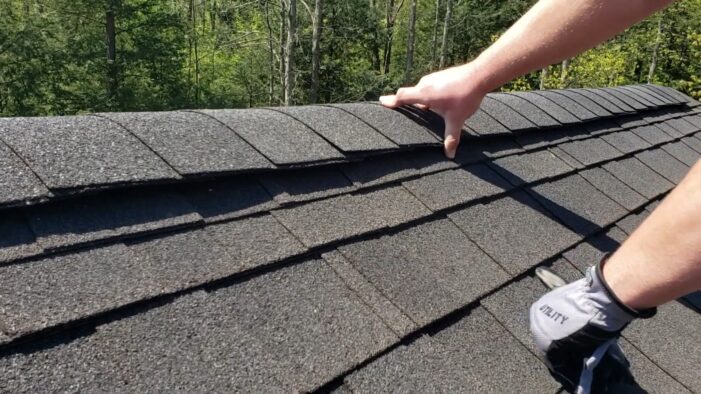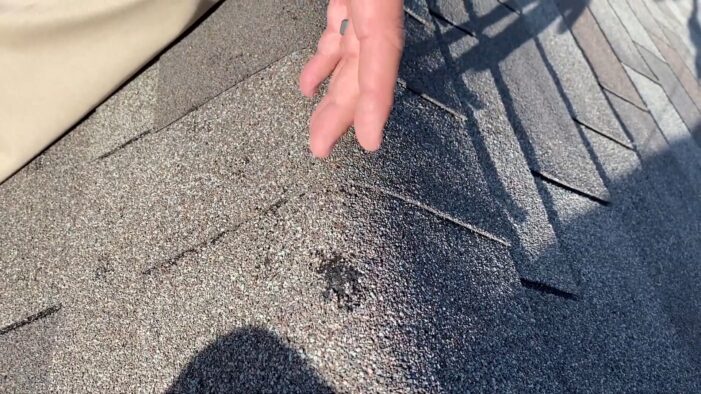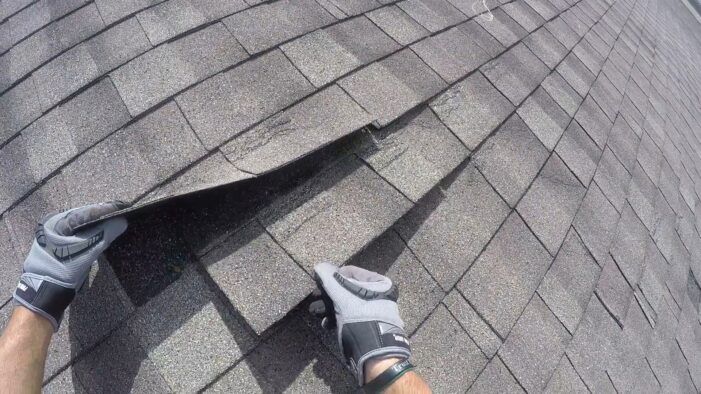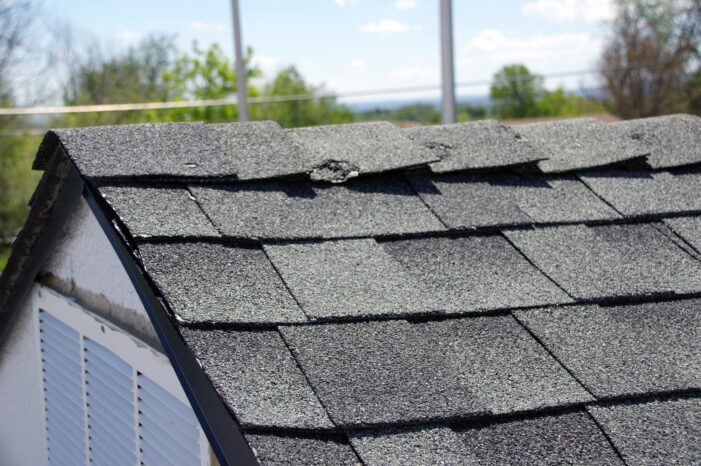When Mother Nature vents her fury through a hailstorm or a strong gust of wind, your home’s first line of defense is the roof and siding. But what happens when these protective barriers take a beating? Knowing how to spot hail and wind damage can save you from costly repairs, maintain the aesthetic appeal of your home, and, more importantly, ensure your family’s safety.
This blog post will guide you through the steps to inspect your roof and siding for hail and wind damage. Fear not! We won’t throw complex jargon at you. Let’s break it down and make this a breeze.
Hail & Wind Damage Explained
Hailstones can range in size from tiny pebbles to large softballs, and their impact can cause varying degrees of damage to your home. The damage is not always visible and might not immediately cause leaks, but it can weaken your roof and siding, leaving them vulnerable to future weather events.
Wind, on the other hand, doesn’t just blow off shingles or siding panels. The pressure changes can lift materials, loosen nails, and creating openings for water to infiltrate. Over time, this can cause significant damage.
Spotting Hail Damage on Your Roof
- Check for Dents: Start by looking for dents on the metal parts of your roof, such as the flashing, vents, or chimney cap. If hail has caused visible damage to these parts, it’s likely that the shingles have also been affected.
- Inspect the Shingles: Hail damage can appear as random dark spots or areas where the granules have been knocked away. These spots might feel soft to the touch, similar to the bruise on an apple.
- Look for Cracks or Holes: Hail can crack or puncture shingles, especially on older roofs. Be cautious of any leaks inside your home, as they might indicate a hole in your roof.
- Examine the Gutters and Downspouts: Check for granules accumulating in the gutters or at the downspouts’ exit. A significant amount of granules might indicate severe hail damage to your shingles.
Spotting Wind Damage on Your Roof
- Look for Missing Shingles: Wind damage is generally easier to spot. Start by looking for shingles that have been blown off your roof.
- Check for Curling or “Lifted” Shingles: High winds can cause shingles to curl or lift, breaking the seal that keeps water out. From the ground, lifted shingles might look like random dark patches.
- Inspect for Loose Debris: After a windstorm, look for loose debris on your roof or around your property. This can be an indication of damage.
Spotting Hail and Wind Damage on Your Siding
- Check for Dents and Chipping: For aluminum and vinyl siding, hail can cause dents. On the other hand, for wooden siding, look for chipping or divots.
- Look for Cracks or Breaks: Both hail and wind can cause cracks or breaks in vinyl siding. Check for pieces that may be loose, missing, or out of place.
- Inspect for Discoloration: Hail can sometimes cause the paint to chip off, resulting in noticeable discoloration.
- Check for Impact Marks: On vinyl or aluminum siding, hailstones can leave behind distinct impact marks.
- Look for Loose or Missing Panels: Wind can rip siding panels off your house, especially if previous damage has loosened them.
Post-Inspection Steps

If you’ve identified signs of damage, take the following steps to ensure the safety and longevity of your home:
- Document the Damage: Take clear, high-resolution photos of all damage. This will be useful for insurance claims and to help contractors understand the extent of the damage.
- Contact Your Insurance Company: Most home insurance policies cover hail and wind damage. Reach out to your insurance provider as soon as possible to report the damage and start the claims process.
- Get a Professional Inspection: While a DIY inspection is useful, a professional roofer or contractor can provide a more thorough assessment. They have the experience and expertise to spot less obvious signs of damage.
- Schedule Necessary Repairs: Once you’ve had a professional inspection and have contacted your insurance company, it’s time to schedule the repairs. Don’t delay this – what seems like minor damage can lead to more serious problems if left unaddressed.
Prevention and Maintenance
While you can’t control the weather, regular maintenance can help minimize potential damage from hail and wind:
- Regular Inspections: Schedule professional roof and siding inspections at least once a year and after any major storm. This can help you catch and address damage early.
- Tree Trimming: Trim overhanging tree branches near your home to prevent them from falling on your roof or siding during a storm.
- Secure Loose Objects: Before a storm hits, secure or store any loose items outside your home, such as patio furniture or garden tools. These can become windborne projectiles that can cause damage.
- Install Impact-Resistant Materials: If you live in a hail-prone area, consider using impact-resistant shingles and siding. While they can’t prevent all damage, they can significantly reduce it.
Hidden Hail Damage

- Loss of Shingle Granules: The loss of granules might not seem severe at first, but it can expose the underlying asphalt to harmful UV rays. This exposure can accelerate the aging of your shingles, leading to leaks and other issues down the line.
- Mat Fracturing: Hail can cause the fiberglass mat beneath the shingles to fracture. While these fractures aren’t visible from the outside, they can lead to more severe damage over time. A professional can spot mat fracturing using specialized tools like infrared imaging.
Hidden Hail and Wind Damage on Your Siding
- Moisture Damage: Both hail and wind can allow moisture to infiltrate your siding. This can lead to problems like mold growth, wood rot, and insulation damage.
- Structural Damage: Severe storms can cause structural damage to your siding, leading to issues like wall buckling. While not immediately visible, these issues can become severe over time.
Hidden Wind Damage

- Seal Strip Damage: High winds can damage the seal strips that bind the shingles together. Damaged seals can allow water to seep under the shingles, leading to leaks and water damage.
- Structural Damage: In extreme cases, high winds can cause structural damage to the roof deck. While this damage isn’t visible from the outside, you might notice signs inside your home, such as a sagging ceiling or cracks in the walls.
Advanced Tools for Detecting Hail and Wind Damage
While a visual inspection can reveal a lot, there are advanced tools that can help detect less visible forms of damage. Some of these include:
- Infrared Imaging: Infrared imaging can detect temperature variations in your roof or siding, revealing hidden damage like mat fracturing or insulation damage.
- Moisture Meters: These devices can detect moisture levels in your siding or roof, revealing potential water damage.
- Drones: Drones equipped with high-resolution cameras can provide a bird’s eye view of your roof, making it easier to spot missing shingles or other damage.
- Hail Impact Gauges: These gauges can help measure the impact of hail on your roof or siding, providing a more accurate assessment of the potential damage.
Final Words
Understanding how to spot hail and wind damage on your roof and siding is crucial for maintaining the integrity and safety of your home. Remember, regular maintenance and inspections are your best defense against the unpredictable wrath of Mother Nature. When damage does occur, prompt action is key to preventing further issues. So, equip yourself with this knowledge, and you’ll be well-prepared to deal with the aftereffects of any storm.
We hope this comprehensive guide has been helpful in demystifying the process of identifying hail and wind damage. With this information in hand, you’re better equipped to protect your home and your peace of mind. Remember, when in doubt, always turn to a professional for advice or an inspection. It’s better to be safe than sorry when it comes to the well-being of your home.

